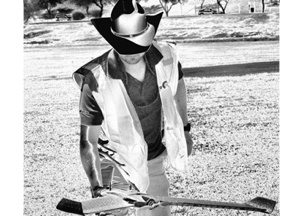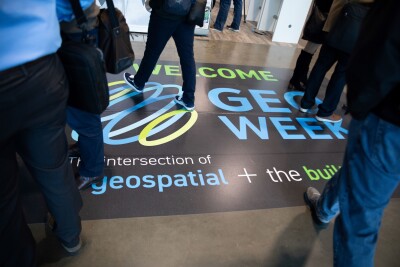“I am going all in at the end of the poker game, actually the beginning of the poker game.”
Nikolas Smilovsky is the mapping division supervisor at RDO Integrated Controls, the largest John Deere distributor in the world and a major distributor of Topcon products. RDO Integrated Controls boasts 105 offices worldwide, and does billions of dollars in business every year with the farming and construction industries. Over the last two and a half years, as RDO has begun to invest in non-traditional mapping services, Smilovsky’s mapping division has become heavily involved with researching and selling mobile LiDAR, terrestrial LiDAR, and GIS solutions. Within the past 8 months, they’ve moved on to UAV and UAS technologies, deciding to distribute Sensefly’s UAS solutions. Smilovsky describes the mapping unit as the “bleeding edge of technology for the company,” and the portion of RDO that works most closely with emerging businesses.
Smilovsky himself has a background in GIS, with a Master’s in GIS from Arizona State University and more than a decade’s worth of experience in GIS mapping. Today, in addition to working with RDO Integrated Controls, he teaches GIS in the graduate program at Arizona State University. Knowing that he has one foot planted firmly in the mapping industry’s future and another in its past, SPAR caught up with him for a chat about UAS technology.
Topics discussed: topo mapping, FAA regulations, UAV accidents, how to get a head start with UAVs, agricultural mapping, future uses of the UAV, Amazon’s UAV program, negative “drone” PR.
SPAR: What can the mapping industry expect this technology to do? What does it mean for a traditional surveyor?
Nikolas Smilovsky: For the traditional land surveyor who does a broad topo map, the days of doing it the old way are numbered. You can fly a site in 20-30 minutes that would normally take a week’s worth of manual labor. I’m not saying the surveyors will be out of a job, what they’ll be doing is flying a UAV instead of using a handheld GPS or a total station. And it’s very reasonable—you can get a UAS at a price point of $30,000-$50,000.
SPAR: We hear a lot about how the technology is good for agriculture, but how do you think it will affect smaller agricultural operations? Is it sufficiently advanced that a small operation can use it properly?
NS: I think you will see companies come out and say, “Instead of using a normal plane that flies from the nearby city that costs $15,000, we’re going to do the same thing that they would do to fly your crop, except we’re going to do it with a UAV for $3,000. And then we’re going to turn the data around twice as fast.” In that sense, the UAV is going to make a cheaper product, and it will make those kinds of services more viable for smaller firms.
SPAR: Are there other uses for the technology that you can foresee?
NS: I think distribution will be big. At the last SPAR conference, I watched a presentation about how UAVs are going to deliver medical aid in places where there are no roads. 30-40% of the world’s people live in areas that don’t have roads to their villages, and it’s really hard to get aid to them. The gentleman spoke about a rotocopter system that would fly from one village to another automatically, carrying a couple of pounds’ worth of cargo to each village—antibiotics, anti-venoms, and vitamins, for instance.
SPAR: Do you think UAVs will ever be used for delivering something like Amazon packages or a pizza?
NS: I think those kinds of things are going to take a lot longer to happen. But I do believe that you are going to see the drone go into a lot of areas that might not be apparent right now. Safety, for instance, I think that’s going to be huge. Think about what’s going on in Africa right now with the Ebola virus—that’s pretty scary. Automated machinery like this could fly into an area and deliver aid without contamination. I think what this sort of technology can do is limitless.
SPAR: It’s clear that the technology is incredibly useful, and it looks to me like you and RDO are going all in for UAVs. Are you worried that there will be some unforeseen difficulties as a result of US regulation?
NS: Honestly, I have been asked this question a hundred times, if not a thousand. But it’s a good question, and I would start off saying that you would be absolutely foolish not to know the potential of UAVs—if not right now, then in the very immediate future. Forecasters are saying that the market will reach multiple billions of dollars in the United States alone. That’s a large market.
SPAR: So you think it’s a good time to start using the technology?
NS: Right now, I believe it’s the perfect time to invest. Right now you can purchase a UAV and fly under the AMA rules, and get some practice under your belt at local RC parks or other private areas. I’m not saying, by any means, that you should publish data or sell commercial products. What I’m saying is that you should get the methodology down, get the tech down, know what it does, know the pros, know the cons. Do this so that the moment the FAA gets their act together and publishes something, you’re already on the ground running and not playing catch-up.
There’s a big chunk of cheese in the UAV market, and we are either going to position ourselves for it now and be ready, or we’re going to be playing catch-up while people are capitalizing on it. It’s only a $30,000-$50,000 buy-in – hardware, software, training, delivery, everything – it’s not a massive investment. I mean, it’s pretty reasonable.
SPAR: In other words, you’re going all in with your investment in UAVs. You’re not hedging your bets at all.
NS: Yes. I am going all in at the end of the poker game—actually, the beginning of the poker game.
If I were going to hedge my bets on anything, it’s that the FAA is not going to meet its deadlines in one fell swoop. Technically, they’re supposed to have recommendations in by the end of this year. So what we at RDO believe, and what a large number of people in the mapping industry believe, is that ultra-lightweight drones will be regulated properly first for use in certain circumstances and situations. After that, I think you’re going to see regulations come out in waves, in tiers. Certain industries like mapping, and certain types of UAV like the ultra-light-weight fixed wing category will be regulated properly first.
Also, remember that the FAA is not a governing body in the respect that they can send out police to go quarantine or arrest people. The USDA, which is a government entity, has told farmers that by the end of this year, they’re going to circumnavigate the FAA’s rules and let farmers use UAVs if they want. So I think the strings are being pulled and it’s just a matter of time before regulations are released.
SPAR: Since the regulatory issue will likely be resolved, or at least circumvented, do you think there could be any other issues? Public opinion, for instance?
NS: I will say that some of the negative PR has probably stagnated the situation a bit. I can’t tell you how many times I have gone into a client’s office and immediately started with the “UAV vs. drone” talk. I always qualify that this drone is not used for military purposes, this drone is not used for hunting people down. Also, because we don’t have live video feeds, the drone is not used for surveillance. It’s a mapping device. Once you qualify that to clients, I don’t think it’s a problem.
Also, there’s something that’s known as “negative PR,” which is still good PR. So I think the good effects of this public awareness outweigh the bad effects. I think it’s most important that public awareness is there.
SPAR: That being said, how long do you think it will take before we see UAVs being used in more publicly visible ways? When will I see one in my city?
NS: I think that it will be some time before you see drone use in urban areas. I think that this is going to be a niche market for a while. Drones will be used in certain industries, like construction. Or, at the very least, they will be used in areas that are not heavily populated by people. I mean, just imagine how dangerous it would be to fly around Times Square with a rotor drone and have it go down into an intersection with two thousand people in it.
SPAR: What do you think is the most important limitation on the development of the technology? Is it technical? Regulatory?
NS: I would say the FAA. The biggest limitation is absolutely regulatory. In other countries, UAVs are doing some really neat things. The US is lagging behind. That’s also a reason I think you’re going to see it regulated properly soon, because the rest of the world is doing it and we’re falling behind.
SPAR: I like to end with a wide-open question. What else do you have to say about the future of UAV technology?
NS: It’s coming, and we can’t stop it—I don’t think we’re going to be able to stop it at all. I mean, people are telling us straight up: “Who’s going to tell me that I can’t fly this on my own land?”
I will say that I bet, unfortunately, we’ll see some accidents with UAVs. With every new technology, you have these ebbs and flows of progression and regression. I think we’ll see a drone kill somebody by accident, or another bad thing will happen. Someone will be negligent. I mean, you can already see people flying drones over areas with people underneath. We’ll probably see some backlash because of those one or two not-so-intelligent people. But I think the technology will prevail, because it’s just that important.






